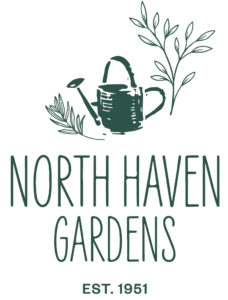Project List: Azaleas & Other Acid-Loving Plants Planting and Maintenance
**North Haven Gardens Does Not Offer Azalea Planting Services.
SITE
The ideal location for Azaleas, in general, is in a position that receives morning sun and afternoon shade; avoiding spots that receive reflected heat from buildings or paved surfaces. This typically means the east, northeast, or north sides of your home.
SOIL AND BED PREPARATION
For clay soils native to our area, start by excavating to a depth of at least 6 inches and mixing in 2 inches of Expanded Shale to aid drainage. Blend ½ bag of Vital Earth Compost, and ½ bag Azalea Mix PER PLANT to create a raised bed. This combination will provide the acidity that azaleas need as well as improved drainage. These are our minimum recommendations. More thorough preparation can include the addition of Lava Sand, Green Sand, Horticultural Corn Meal, Coco Coir fiber, and an acidifier. The addition of these other amendments will improve plant health and performance for you.
WATERING
It is most important that the root ball be soaked in a root stimulator solution at planting. Azaleas have shallow, fibrous root systems that dry out more quickly than other shrubs, meaning that watering is of paramount importance if you are to establish them properly. In addition to watering from an irrigation system, attentive hand watering will always be REQUIRED for the first year, as well as monthly applications of root stimulator. Always try to keep all water directed at soil level to avoid wetting the plant’s leaves.
FERTILIZING
The small roots of Azaleas need consistent feeding with acidic‐based food in order to bloom well. Re‐blooming varieties should be fed 3 times per year: early spring, summer, and fall. Traditional varieties are fertilized after major blooming periods are finished — about January to February, then again in June, and once more in September to October.
PRUNING
Major pruning on Azaleas is typically only done once, after the first spring bloom. Thereafter, light tip pruning of plants can be done between blooms.
MAINTAINING
‘Top dress’ the soil 2‐3 times per year with additional Azalea Mix, always maintaining a mulch layer 3 inches deep on your plants to help provide continuing acid soil conditions. We recommend Pine Bark, Cedar, or Pine Straw. There are soil acidifiers that can also be applied if additional acidity is necessary. The addition of liquid amendments or sprays, such as Seaweed Plus Iron will help as well.
For Azaleas, Camellias, Gardenias, Hydrangeas, and other Acid‐loving plants:
Remember that most problems arise from planting in the wrong site or soil. The most common problem for these shrubs is getting too much sun or being simply too hot, which manifests as tip or spot burns on the leaves, leaf curling, and an overall stunted appearance.
Chlorosis, an extremely common condition caused by a lack of available iron in the soil, manifests as yellowish or pale leaves with green veins. Chlorosis is generally remedied easily by applying fertilizer specified for acid‐loving plants or by-products such as Ironite.
Need further help? Our Garden Advisors are here and happy to assist! Visit North Haven Gardens to check out our plant nursery or give us a call at 214‐363‐5316 to discuss additional questions.

